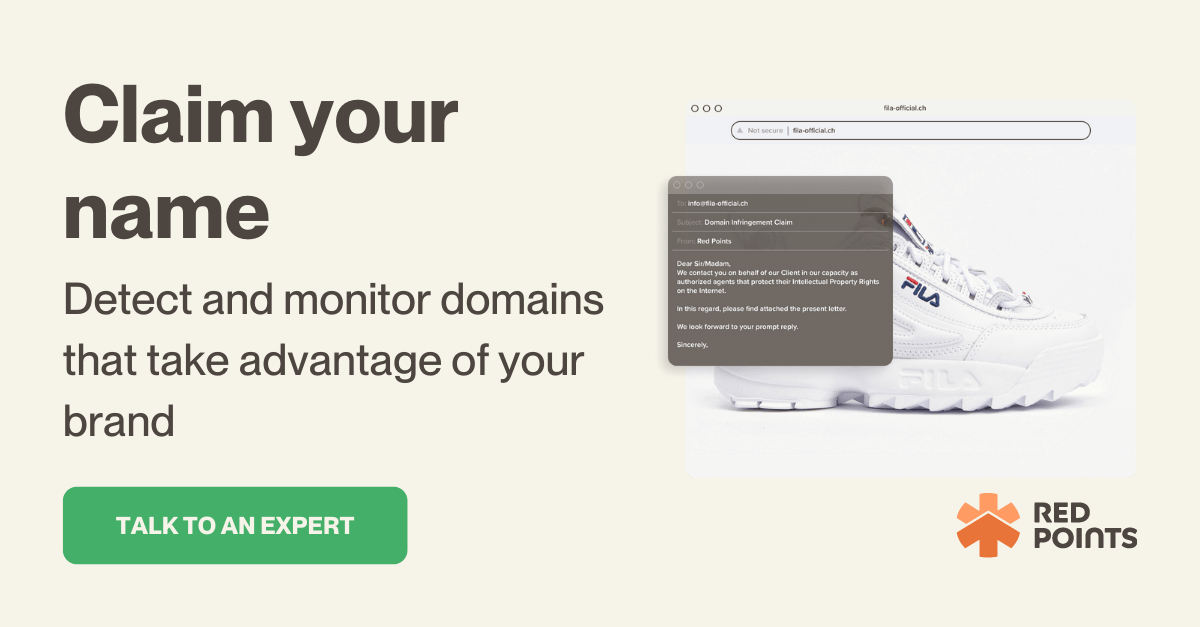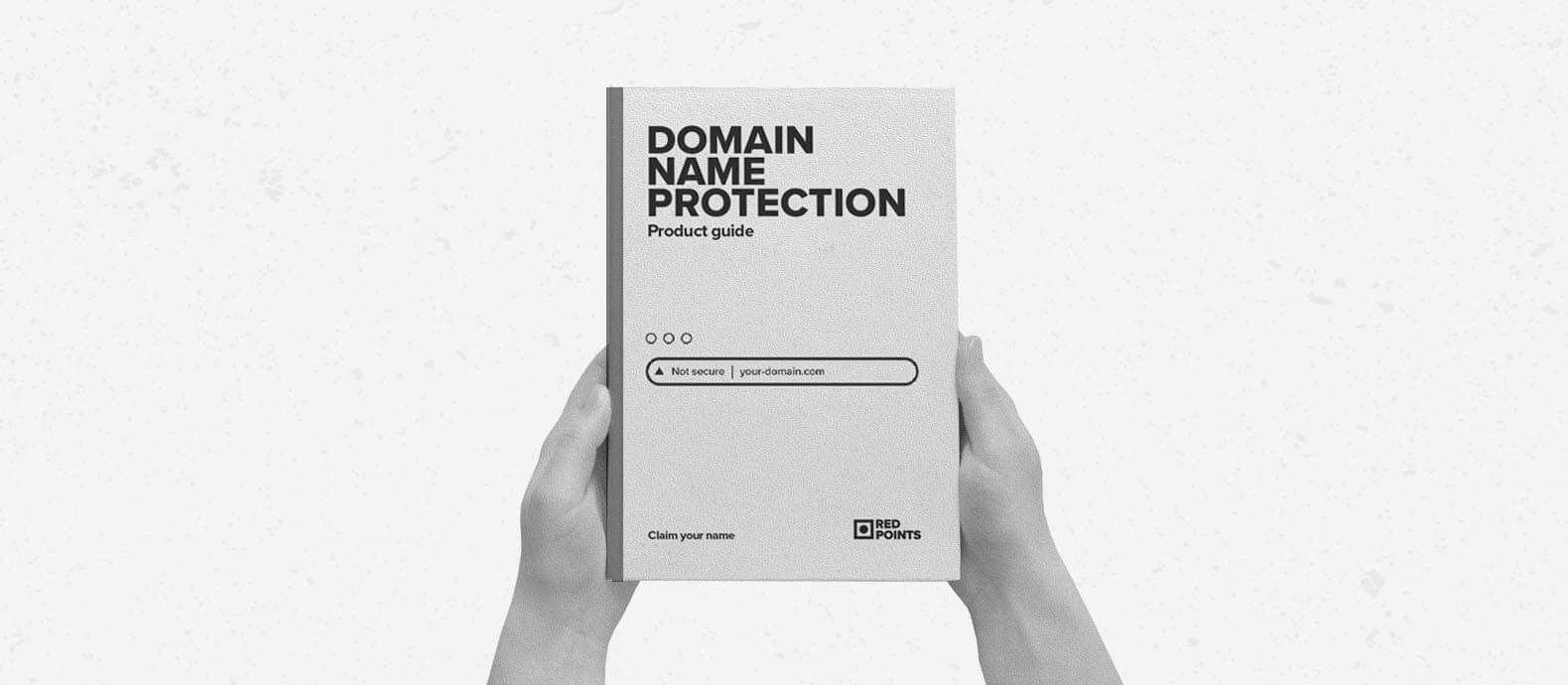Domain names are more than simple web addresses. They are the entry point for a company’s business information, online shop, and brand recognition. However, they get frequently tackled by infringers that try to steal or abuse content to profit from it.
In this article, we give you a full guide on how to protect domain names on hand. You will learn how to choose and register domain names safely, how to protect your domains under intellectual property rights (IPR), and the best solutions for enforcing domain ownership.
How to choose a strong domain name
Your domain name is the address of your digital property and it should be chosen carefully. It gives the first impression of your brand to visitors, can help your SEO ranking when using a keyword in your domain name, and has a defining factor in terms of brand recognition.
It is recommended to use a “keep it simple” approach for your domain name. It should be short, easy to type, and easy to pronounce. Hyphens or numbers should be avoided as they make it more difficult. The domain extension, “.com” is the most popular and therefore easier to remember than other domain endings like “.org” or “.net”.
Domain names should also be unique and distinguishable from the competition. They can contain a keyword that reflects the business of the company which can improve SEO ranking. However, keyword-stuffed domain names can quickly become generic and unmemorable. Brandable domain names like “oatly.com” are better than generic keyword domains like “oatmilk.com”.
Lastly, check if your chosen domain name is available on social media sites and if it is already trademarked by someone else to avoid legal issues.

Are domain names copyright protected?
Domain names are not protected by copyright law. A copyright protects the original works of a creator including literary work, music, art, software codes, architecture, and more. Ideas, facts, systems, or methods of operation are not protected by Copyright.
How to protect domain names
Protecting your domain name entails several steps and requires a broad range of tasks. In the following, we walk you through the process of safely registering your domain name and enforcing domain ownership protection.
Use a trustworthy registrar and secure your setup
Protecting your domain name begins with registration. Use a registrar that has built up a good reputation over time and is responsive to customers in case you need help. ICANN provides a list of accredited registrars where you can look for registrars and select by country or territory.
You should also keep an eye on login security and your contact information when you first register the domain. Make sure to choose a password with a high-security level to avoid easy access to your domain name.
To make communication easy and seamless, give the registrar a permanent email address so that your domain provider can contact you if they need to.
Keep a close eye on the expiration date
Once you register your domain name, it is important to monitor the expiration date to avoid losing it. This becomes even more important when you have registered multiple domain names. Rather than renewing it every year, you can register it for up to 10 years which makes it less likely that you’ll forget to renew it annually. You might also want to consider an “auto-renew” function of your registrar to renew your domain name automatically before it expires.
Monitor other similar domain names
Additionally, it is recommended to register alternative versions of your domain name to protect the main domain name. That might consist of similar domain names, misspellings or typos of your web address, and alternative top-level domains like “.net” or “.org.”.
That way, you can redirect visitors who accidentally mistyped your web address to your correct website. It also helps to prevent becoming a victim of typosquatters who register fraudulent websites under similar domain names. If alternative versions of your domain are already registered, you can consider buying them.
Domain ownership protection
Many registrars offer domain ownership protection that protects your domain by prohibiting the transfer, change, or deletion of your domain unless the registered owner explicitly gives permission by submitting a form. This function prevents domain loss caused by malicious intent and is secured by identity proof or organizational vetting.
Some domain registrars offer different options that provide different levels of domain protection. They can range from hiding your contact information, installing a proxy email that filters other email requests, protection against domain hacking, or constant security monitoring against threats.
Domain name protection under IPR
You can consider registering your domain name as a trademark to enforce domain protection and secure it under IPR. Like any other prospective trademark, such as words, phrases, symbols, or color schemes, domain names have to pass various tests before being registered as a trademark.
The main criteria under trademark law are distinctiveness and likelihood of confusion. This is because trademark law is designed to protect consumers and courts that want to ensure that consumers can easily identify the source of the goods and services that they are purchasing.
Registering your domain name as a trademark makes enforcement easier in case of misuse and can help to prevent reputation damage.
Tackle domain squatting at the source
A common threat that you want to protect your domain name against is known as domain name squatting. The technique is used by infringers who register a domain in the name of an existing brand or a slightly different version of a registered domain with malicious intent.
If you notice that a scammer has copied your website, you should start taking action by sending a cease-and-desist letter to the site admin or domain registrant of the fake website. You can usually get this information from domain registrant search services like ICANN. In parallel, notify the domain registrar about the misuse. Registrars like GoDaddy.com are aware of the problem and might be able to help you.
If contacting the domain registrant or admin is not successful, you should send a cease-and-desist letter to the content management system (CMS), which runs the website. Popular CMS platforms are Shopify, Wix, or Squarespace for example.
In case of no response from both the site admin and the CMS platform, you can send a cease-and-desist letter to the next level above, which is the server host. Hosts are legally bound to IP law and therefore expected to comply with your request and help you protect your domain name.
Domain spoofing protection
Fighting domain name abuse manually and on a single-case basis can be a long and frustrating process as scammers often don’t respond or swerve enforcement.
An efficient way to enforce domain ownership protection is by applying specialized software that helps companies protect their domain names at scale. Red Points’ technology-based solutions streamline the process of taking down fake websites before they harm your brand.
Next steps
Scammers frequently steal content and domain names to profit from it. They divert traffic to fraudulent websites, sell counterfeits on look-alike sites, or steal sensitive information from online users. Brands suffer from the repercussions through reputation damages, diverted customers, and revenue losses.
Red Points’ domain monitoring software can help protect your domain name. Our anti-spoofing technology protects your domain names in three main steps finding, removing, and clustering fake websites. We detect incidents at scale on multiple platforms and report takedowns immediately. Repeat offenders are stopped by uncovering their identities and by taking legal action. Contact us to get more insights on how you can benefit from our trusted domain brand protection services.






